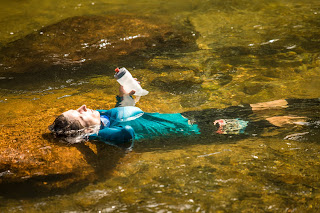 |
| Buckles from the Grand Slam |
It's almost time for Western States 100 again (this is my fourth year in a row) but this year I wanted to try something new and attempt a bigger challenge for the sake of variety. So I'll be running the Grand Slam of Ultrarunning, one of the classic ultra challenges which dates back to 1986. It involves running four of the oldest 100 milers in the US in one summer - Western States 100, Vermont 100, Leadville Trail 100 and Wasatch Front 100. That totals 400 miles of racing with around 74,000ft of ascent and more descent due to WS100 being a net downhill course.
Here's Keith Knipling's 2006 set of profiles for the four races:
I've only ever run the first of these races and have never tried to run 100s this close together. I'm definitely nervous. However, one of the biggest draws about ultrarunning is that it gives runners the chance to push their limits and try things that initially don't seem possible. Since I've already run WS100 a few times it made sense to try the Grand Slam since I at least know how I'm likely to feel three weeks after the first race and last year I think I'd have been ok to run that far again. The other big factor is that WS100 has a lottery and the guaranteed routes to entry (placing top 10 the previous year or getting a spot from top two in a Montrail Ultracup race) are getting more and more competitive every year. There's no guarantee I can keep qualifying so it makes sense to try this while I have a WS100 entry for certain.
Here's an interview I did about the Grand Slam for Julbo.
Training For Multiple 100 Milers
In terms of training I've mainly focused on WS100 since if you're fit enough to run one race like this really well then the main issue for doing four is recovery. Doing four times the training would have been ridiculous and just led to injuries and a lot of slow running. Besides, each 100 will be a great long training run for the next one. The one difference to previous years is that I've given a bigger focus to WS100 training and made my build-up harder in terms of training intensity but lower in terms of number of races and length of races. I've been conservative at the build-up races too since I can't afford to start the Grand Slam tired or injured.
Unfortunately I have had a couple of pieces of bad luck with injuries. A slight knee issue from last December stayed with me until February when I took a month off and it basically went away. I had the tiniest inkling it was back when running in Peru last month so opted to play it safe and keep my eye on the prize of WS100 and the Grand Slam. It doesn't concern me and I can't see it being an issue, but I've played safe recently.
The more annoying injury is that as soon as I got back from Peru I was running on a bike path, placed my foot on the edge of the pavement and twisted my ankle worse than I ever have. Luckily it seems to be a grade 1 ankle sprain with minor damage that meant I was running again within about four days and doing technical all-out trail running within a week. It also held up through a tempo long run at the San Francisco marathon at the weekend but it's not perfect and the remaining 11 days to WS100 will be helpful in making sure it has time to heal, especially as it's taper time and the hard training is over with.
Anyway, I'm very excited about WS100 and it seems to get more enjoyable each year. Then I can focus on race two, but it's definitely a case of taking it one at a time.
Grans Slam Stats
Below are some stats about the Grand Slam with more details here:
- Completed 266 times since 1986 by 234 different people
- Number of finishers from England: 3
- Record for the combined time: 74h54m16s by Neal Gorman in 2010 (Neal was meant to be running WS100 and Hardrock 100 this summer but is out of at least the first with illness)
- Number of people who've broken 80 hours for the Grand Slam with these four races (in the past Old Dominion 100 and Arkansas Traveler 100 could also be included, but not in recent years): 6
- Number of women who've broken 80 hours for the Grand Slam: 1 (bet you can guess her name...I'll give you a hint - she's the only person to win Western States and Comrades, male or female)
What If Four 100s Is Too Easy?
For those who think the Grand Slam is just too short, there's the option of extending it to six 100s for The Last Great Race which adds Old Dominion 100 and Angeles Crest 100 to the Grand Slam. Or you could see how many 100s you could do in a year, like Liz Bauer who ran 36 of them last year. None of this is on my radar in the foreseeable future, which my wife is very glad to hear.
















































